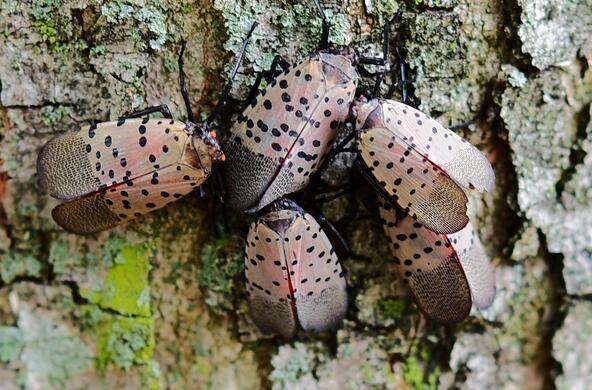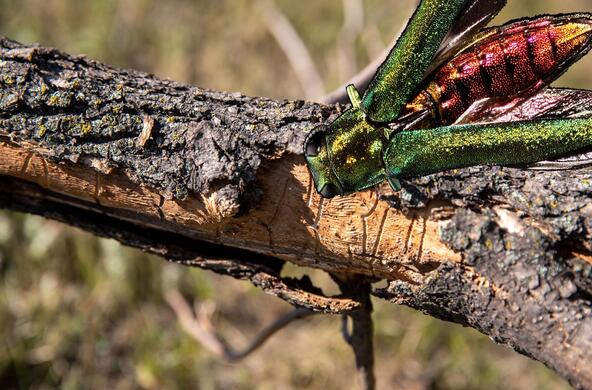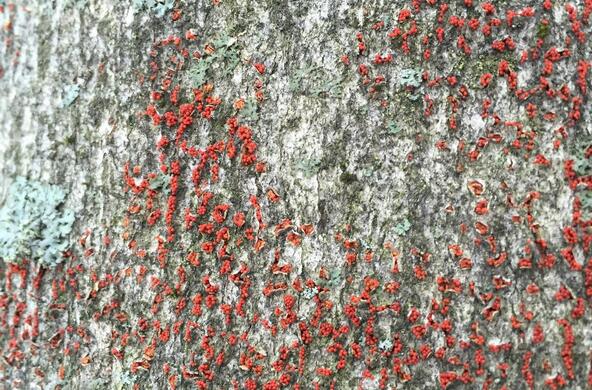Breakbulk cargo imports into the United States are on the upswing, and so are discoveries of dangerous wood-boring pests in the dunnage and wood packaging material (WPM) that protect these imports in transit. Unfortunately for importers and carriers, violations can trigger huge fines, costly re-exportation of entire shipments, and a cascade of disruptive knock-on effects.
The pests that trigger these repercussions have destroyed millions of trees in the US. They can “wipe out an entire species of trees in a matter of a few decades,” Gary Lovett, a forest ecologist with the Cary Institute of Ecosystem Studies, said during an Aug.19 Journal of Commerce webcast on International Standards for Phytosanitary Measures No.15 (ISPM 15) and its potentially dramatic effects on imports. The Cary Institute is a member of an informal WPM-Dunnage Coalition formed in 2019 by Houston-based project and breakbulk logistics industry executives and stakeholders to find proactive ways to address inadvertent ISPM 15 violations.
Because after-the-fact eradication efforts are costly and often ineffective, the focus of ISPM 15 is stopping the bugs from entering the country in the first place. The great frustration for cargo owners is that these invasive insects are regularly found in stamped and documented WPM that has been — or at least appears to have been — treated by heat or fumigation according to ISPM 15 regulations.
That the US Customs and Border Patrol (CBP), which enforces ISPM 15 on behalf of the Department of Agriculture (USDA), continues to find dangerous insects in WPM that appears to be ISPM 15–compliant, “tells us [ISPM 15] is not working well enough,” Lovett said. And given the high cost of CBP enforcement measures for violations, shippers and carriers cannot simply rely on the existing international ISPM 15 system to ensure they are using safe dunnage and WPM, he said.
According to James Garland Hurst, a customs and international trade attorney with Givens & Johnston, ISPM 15 stamps do not guarantee compliance or trustworthiness. “I’ve just seen too many cases where CBP has found — or claims to have found — violating insects,” he said during the webcast.
However, USDA’s Animal and Plant Health Inspection Service (APHIS) and CBP stand by the ISPM 15 system.
The “short answer” is that the system is trustworthy, Tyrone Jones, trade director, global forestry products for USDA-APHIS, said during the webcast, citing a 2009 US Forest Service study that found just 0.11 percent of properly marked imports were noncompliant.
“We are trying to improve that,” Jones said. “We’re not saying that [the pests] are not there. We’re just saying that overall, you can trust the mark. Percentage wise, 99.89 is still pretty good.” John Sagle, deputy executive director, agriculture programs and trade liaison, at CBP, likewise said that current ISPM 15 treatments are appropriate for mitigating pest risk in WPM. “The issue does not lie with ISPM 15 regulations and standards themselves; it rests on effective supply chain management and oversight,” he told The Journal of Commerce.
But from the perspective of breakbulk shippers and logistics providers, a dearth of basic information on violations and WPM sourcing compliance from the regulatory and enforcement side hampers their ability to perform this oversight.
Hurst noted, for example, that there is no available list of WPM producers that have previously violated ISPM 15 regulations. “Right now, if you’re purchasing stamped wood overseas, it’s difficult to do your due diligence,” he said. “You don’t know if they’ve violated the law before.”
The routine release of data on violations to the affected parties would also help importers accused of violations, which need to contact their insurance carriers and often want to sue the WPM producers overseas. They need information to do that, but to get it, “an importer typically has to go through a FOIA [Freedom of Information Act] system,” Hurst said. “It takes months” to get photos, reports, and evidence related to violations, he said. In Hurt’s view, there’s no reason CPB or USDA shouldn’t hand that information over as a matter of course. “It almost seems as if CBP is protecting its detection methods,” he said during the webcast. “No one is trying to smuggle in bad wood. Everyone’s trying to comply with the law. CBP should be open about it.”
As Lovett put it, “We’re asking importers to make good choices about wood packaging material, and we’re not giving them the tools to make those choices. That’s really something that needs to be remedied.”
‘Zero tolerance, zero mitigation’
In addition to their potential for ecological devastation, invasive pests in WPM can be commercially disastrous for importers, ocean carriers, and others in the supply chain.
Whether the fault lies in fraudulent stamps or ineffective treatments, as some industry members believe, or in inadequate supply chain quality assurance, as CBP puts it, the discovery of these dangerous wood-boring pests triggers harsh remedies. Fines can be as high as the full value of the cargo, potentially millions of dollars when it comes to project cargo.
And, with a few regional exceptions for dunnage that can be incinerated under strict controls, ISPM 15 violations typically lead to the re-exportation — i.e., the rapid removal from US waters — of anything from simple dunnage to steel coils on skids to part and full charters of high-value, schedule-sensitive project cargo.
“There is zero tolerance, zero mitigation available. It’s basically a strict liability offense,” Hurst said during the webcast. “You could be talking about millions and millions of dollars” for a single insect found in a shipment that includes hundreds of pieces of wood, he said.
Delays in offloading cargo affect carriers as well as importers, especially if subsequent voyages and charters agreements are pushed back, added Diana Davila, project director and Houston branch manager at project forwarder UTC Overseas and a founding member of the WPM-Dunnage Coalition.
Hurst said CBP tends to oppose requests to separate cargo from WPM because there is a chance insects could be released, but separation doesn’t always require opening a crate or breaking WPM. In some cases, simply cutting a strap fastening a steel coil to a pallet would suffice, he said. The offending pallet could then be locked into a container before export, potentially a much more efficient and less expensive method of removal than re-exporting the entire shipment.
At the same time, making remediation easier could have the unintended consequence of reducing penalties for ISPM 15 violations to just another cost of doing business, Lovett said during the webcast. “There would be less incentive for companies to keep pests out of the WPM in the first place,” he said.
Noting that CBP inspects only 1 to 2 percent of inbound cargo, Lovett said the goal should be to stop the bugs at their source, well before cargo is even loaded.
Where are the bugs?
According to APHIS, discoveries of invasive insects in WPM are not evenly distributed across all importers. Although APHIS data includes the type of pests involved in violations, it does not indicate the type of WPM in which the pests were found, Jones told The Journal of Commerce.
The weight of the cargo can give some additional clues as to the WPM type, however. Specialty pallets and sturdier wood packaging materials used with heavier shipments — i.e., project cargo — are involved in the most interceptions, he said.
Larger pieces of project cargo pieces require larger wooden beams, especially at the bottom of crates,“and that’s where they tend to find these bugs the most,” Hurst said during the webcast. “Those have always had the most trouble; because you are talking about an 8- to 10-inch wide beam, ISPM 15 treatment appears to be less effective.”
APHIS says heat treatment has been tested to a successful eradication rate of 99.9999968 percent, attributing failures to human or mechanical errors, such as incorrectly placing thermocouples, devices to measure heat levels, within thick, dense, or large pieces of wood, rather than to the efficacy of heat treatment itself.
More cargo, more violations
Breakbulk volumes are recovering from COVID-19 pandemic lows at the Port of Houston. Throughput of steel, automobile, and general cargo tonnage, excluding containers, was up 13.3 percent in the first half of 2021, according to the port. While this is good news for the country’s busiest steel and breakbulk port, it goes hand in hand with an increase in ISPM 15 violations, said Dominic Sun, director of trade development with the Port of Houston.
Peter Svensson, senior vice president with Clipper Americas, which operates several dedicated breakbulk steel services, said he has also seen an increase in violations at Houston. The carrier, whose subsidiary Clipper Steel is a founding member of the WPM-Dunnage Coalition, spends several million dollars a year on properly treated and stamped dunnage and has a dedicated European staff inspecting before cargo is loaded for shipping. Despite this, they have had several ISPM 15 incidents in the US, according to Svensson.
CBP’s Sagle agreed that although the evidence is anecdotal, it’s apparent that an uptick in breakbulk and project cargo at Houston has led to an uptick in live pests discovered. CBP inspectors are also getting better at finding insects, and “the regulations are stringent,” he said. Violations are also increasing at other US ports, he added, although this information is also anecdotal.
At Houston, shipments with the most pest violations over the past few years have originated in the EU, according to APHIS. However, specifying a particular origin country is difficult because EU countries freely trade materials across borders.
Specific data on violations is hard to come by. CBP does not release information about the number of Emergency Action Notifications (EANs) written, or the amount of cargo re-exported from the US due to EANs. It also does not release any specific information about the sources of infested WPM.
Getting to the source
Project owners and carriers are done with being “reactive instead of proactive” when it comes to ISPM 15, Davila told The Journal of Commerce. To find and tackle the source of the problem, WPM-Dunnage Coalition members are working with the Cary Institute, APHIS, and CBP.
The goal is creating a program through which importers, carriers, and enforcement work with surveyors at WPM origins in a multi-faceted way to eliminate pests prior to loading, Davila said during the webcast. Multiple inspections using CBP methods before and after packing might cover the shipper, the pallet provider, the manufacturer, and the port, she said. Several inspection companies are interested in participating in the project, and the group is working with CBP to organize the necessary training, she said.
Project and breakbulk shippers and forwarders already often contract with surveyors to check equipment prior to shipping. The ISPM 15 surveys would be an additional line item for those inspections, Davila said, and could be part of a program similar to CBP’s Customs Trade Partnership Against Terrorism (CTPAT).
The WPM-Dunnage Coalition and its allies would create a recommended checklist for the inspection companies, Davila said. Early mitigation would cost less than fines, re-exporting, and the potential cascade of associated costs. The program would also help eliminate dangerous pests at the source, preventing the importation of those that slip through inspection.
Under the current system, “we are only addressing the [pests] that are found,” she said. “We’re not addressing all the ones that aren’t found.”






